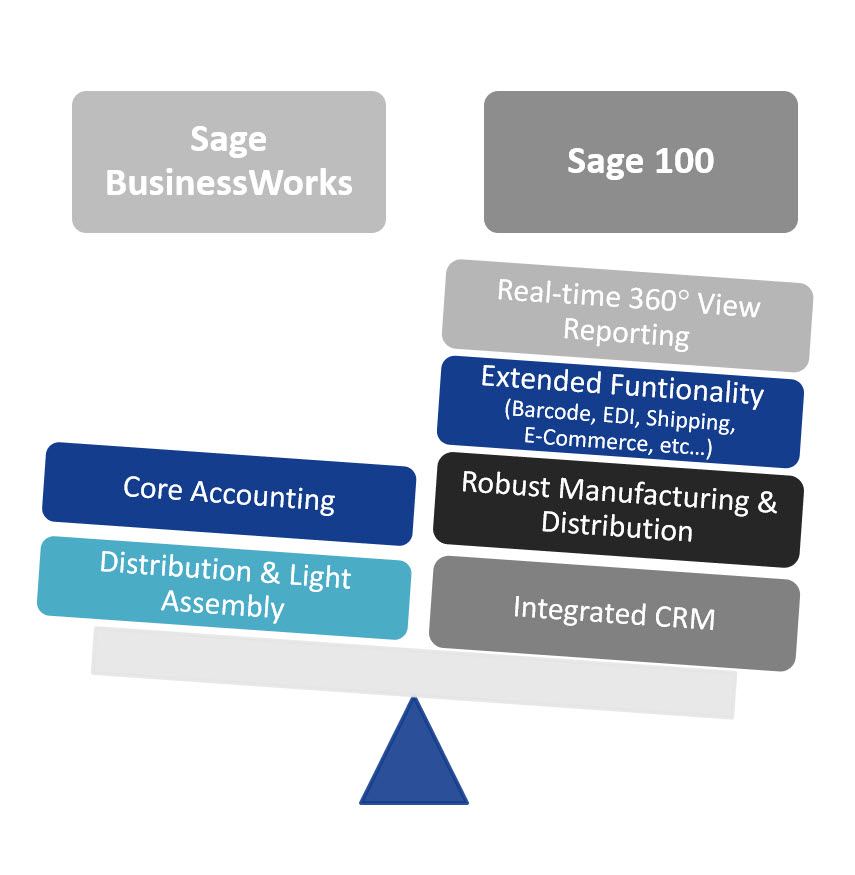Small and medium-sized businesses using Sage BusinessWorks often ask us to explain the key differences between Sage BusinessWorks vs Sage 100. Often times customers start out on BusinessWorks, then experience growth or need more advanced functionality in order to maintain efficiencies.
DWD has been a Sage Software Certified Partner since 2001 and has many years of expertise with both Sage BusinessWorks and Sage 100.
Sage BusinessWorks vs Sage 100 – Key Differences
Why do companies using Sage BusinessWorks switch to Sage 100?
- Business has grown and there is a decline in speed and performance as database grows (performance-related issues)
- Need real-time control and visibility over all business activities to minimize operating costs
- Need Extended functionality (integrated barcoding, shipping, EDI, e-commerce, advanced inventory and warehouse management, etc.)
- Provide anywhere, anytime access for remote users
- Looking for better manufacturing solution – Automate and streamline manual processes, Track labor costs, Better way to plan and track material, Connect multiple systems and databases, Product Costing, Material Planning, Job Tracking, Work Order
- Looking for better Distribution solution – Better visibility and tracking of inventory, lower overhead costs, increase sales with customer and item-specific pricing, e-commerce integration, better track, manage and reduce shipping costs, ability to add online orders
- Integrated CRM solution automates sales, marketing & customer service activities

Sage BusinessWorks vs Sage 100 Side by Side Comparison
| Sage BUSINESSWORKS | SAGE 100 | |
|---|---|---|
| Overall Strength | User-friendly, solid core accounting, payroll and job costing functionality. Email reports as well as customer/vendor documents, ability to invoice through mail or email, user-or role-based security | Integrations, customizable, strong manufacturing & distribution features, maintains performance up to dozens of users, integration between CRM, e-commerce and financials. Data file sizes less restricted. |
| Overall Weaknesses | Decreased performance as soon as approximately 10 users concurrently access. High volumes of data can slow down the system and/or lead to data corruption. Inability to customize data entry screens, add new fields, or add customized functionality. Limited access to 3rd party functionality. Limited ability to customize forms and reports. Only one costing method can be selected for inventory. | Must use correcting transactions to fix errors, batch processing may lead to improper date postings. |
| Number of Users | Up to 45 | 100s |
| Performance & Scalability | Designed for a limited number of users and functions, simple business processes, few integrations to expand functionality. | Supports larger file sizes, companies and user counts, supports SQL database, ability to modify software and workflow with scripting and screen customizations, many integrations available to enhance functionality. |
| Financial Management & Reporting | No dashboard functionality. Limited customization of standard reports. Report-writing add-on available to customize financials. Many reports redesigned for easier export to Word, Excel or in PDF format. | Business Insights Dashboard, Reporter, and Explorer, integrates with Microsoft Power BI, create custom reports with Sage Intelligence Reporting and Crystal Reports |
| Ability to Customize | No customization ability | Extensive codeless customization, change and add screens, unlimited UDFs, ability to fully customize with programming if desired. |
| Best Fit Industries | Financial, Distribution, Light Assembly | Financials, Extensive Manufacturing, Multi-site Distribution |
| Best Fit Company Size | Small to Medium | Small to Large |
| Deployment Options | On-Premise, Hosted Server | On-Premise, Hosted Server, Private Cloud |
| Ease of Implementation | Fairly easy to implement | Smaller software solutions tend to be easier to implement because there is much less flexibility to tailor the system to specific needs. |
| Avg Implementation Timeframe | 1 to 2 months | Core Accounting: General Ledger, Accounts Receivable, Accounts Payable (2-4 weeks) Payroll: (2-4 weeks) Distribution: Inventory, Sales Order, Purchase Order (2-4 weeks) Manufacturing: Bills of Material, Work Order Processing (4-8 weeks) |
| Avg Implementation Cost | $3,000 – $10,000 | $5,000 – $30,000 |
| Pricing Model | License purchase with annual maintenance plan or subscription; concurrent user licenses | Subscription; concurrent user licenses |
| Annual Maintenance Cost | $1,000 – $2,250 | $600 – $30,000 |
Sage BusinessWorks vs Sage 100 Comparison FAQs
Taking the Next Step
Since we’re certified on Sage BusinessWorks and Sage 100, our familiarity with both products means that we can help you compare and contrast Sage BusinessWorks vs Sage 100 with your specific operational needs and business goals in mind. If it’s not the right move, we’ll tell you. If it is the right move, we’ll be there to help you usher in all the benefits of a more advanced ERP solution.
Take advantage of our free Software Needs Assessment to help you find the best software for your unique needs, whether it be Sage 100 or Sage BusinessWorks. Our experts are here to answer your questions and provide objective advice so you can find the right solution.
